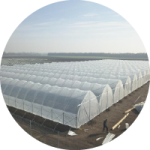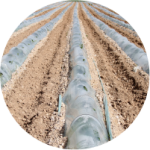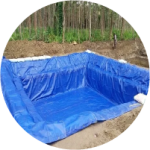1-Ventilation
Ventilation is one of the most important components of a successful greenhouse. If there is no proper ventilation, greenhouses and their growing plants are prone to problems. The main purpose of ventilation is to regulate temperature and humidity at the optimal level and ensure air movement and thus prevent the accumulation of plant pathogens that prefer still air conditions. Ventilation also ensures a supply of fresh air for photosynthesis and plant respiration and may enable important pollinators to access greenhouse crops. Ventilation can be achieved through the use of vents and fans.
2- Lighting
During the day, the light passes through the greenhouse covers and enters the greenhouse and is used by the plants. In the night shul like this, some greenhouses are equipped with growth lights that are lit during the night so that the plants receive more light and increase the productivity of some crops.
3- Cooling
Cooling is usually done by opening the windows in the greenhouse when it gets too hot for the plants inside. This can be done manually or automatically. Electronic controllers are often used to monitor temperature and adjust furnace performance to conditions. For very hot situations, shade houses may be used, which provide cooling in the shade.
4- Heating
The main problem with greenhouse heating, unlike buildings with solid opaque walls, is the amount of heat lost through the greenhouse cover. Since the coverings must allow light to penetrate into the structure, on the contrary, they cannot insulate well. Most greenhouses use natural gas when additional heat is needed.
5- Enrichment of greenhouses with carbon dioxide
One of these very important factors that the growth of all photosynthetic plants depends on is carbon dioxide (carbon dioxide).
As you know, in addition to nitrogen, phosphorus, potassium and micronutrients, plants also need carbon, oxygen and hydrogen. In fact, these three elements are among the most used elements of the plant.
The carbon needed by the plants is provided through the absorption of carbon dioxide from the air. The carbon dioxide of the air combines with water during the process of photosynthesis and provides the necessary materials for plant growth.
This work can also reduce the water consumption of greenhouses and is one of the best sources to supply those sugar refineries.
In most greenhouses, as the air cools and the ventilation valves are closed, the carbon dioxide in the greenhouse air is gradually absorbed by the plants, its concentration is reduced, and the plants face the lack of this gas to continue growing and developing.
On the other hand, considering the high cost of building a greenhouse, it is necessary to adopt an arrangement to obtain maximum photosynthesis and performance.
Therefore, in order to have proper photosynthesis in the greenhouse, one must somehow keep the concentration of this gas at the level of the air outside the greenhouse by doing ventilation, or artificially inject carbon dioxide into the space inside the greenhouse.
The benefits of using carbon dioxide in greenhouses:
- Increased growth and photosynthesis
- shortening the growth period of the plant (5 to 10 percent)
- Premature flowering and fruit ripening
- Increasing the quality and efficiency of fruiting
- Increase in plant dry weight
- Increasing the size and thickness of leaves
- Improving plant stem strength and flower size
- Reduction of incomplete buds in flowers and…









